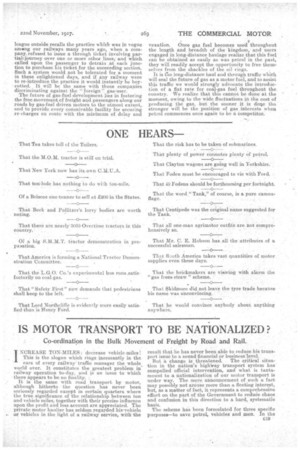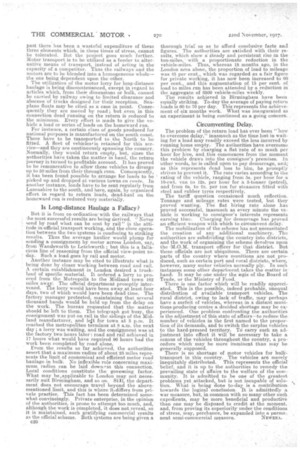IS MOTOR TRANSPORT TO BE NATIONALIZED?
Page 3

Page 4

If you've noticed an error in this article please click here to report it so we can fix it.
Co-ordination in the Bulk Movement of Freight by Road and Rail.
INOREASE TON-MILES: decrease vehicle-miles ! This is the slogan which rings incessantly in the ears of every railway: traffic manager the whole, world over. It constitutes the greatest problem in railway operation to-day, and is an issue to which there appears to be no finality. It is the same with road transport by motor, although hitherto the question has never been seriously regarded except in certain quarters where the true significance of the relationship between ton and vehicle miles, together With their precise influence upon the profit and loss account are appreciated. The private motor haulier has seldom regarded his.vehicle DE vehicles in the light of a railway service, with the result that he has never been able to reduce his transport issue to a sound financial, or business level. But a change is threatened. The critical situation in the nation's higliWay transport system has compelled official intervention, and what is tantamount to a nationalization of our motor transport is under way. The mere announcement of such a fact may possibly not arouse more than a-fleeting interest, but, as a matter of fact, it represents a comprehensive effort on the part of the Government to redude chaos and confusion in this direction to a hard, systematic basis.
The scheme has been formulated for three specific purposes—to save petrol, vehicles and men. In the c19 • past there has been a wasteful expenditure of these three elements which, in these times of stress, cannot be tolerated. But the project goes much further. Motor transport is to be utilized as a feeder to alternative means of transport, instead of acting in the capacity of a competitor. Thus the railways and the motors are to be blended into a homogeneous whole— the one being dependent upon the other. The utilization of the motor lorry for long-distance haulage is being discountenanced, except in regard to articles which, from the dimensions or bulk, cannot be carried by railway owing to limited clearance and absence of trucks designed for their reception. Seaplane floats may be cited as a case in point. Consequently they are moved by road ; but even in this connection dead running on the return is reduced to the minimum. Every effort is made to give the vehicle a load or series of loads on the homeward run.
For instance, a certain class of goods produced for nationa) purposes is manufactured on the south coast. These have to be biansported to the North to be fitted. A fleet of vehiclesi is retained for this service—and they are continuously spanning the country. Normally, they would return empty, but, since the authorities have taken the matter in hand, the return journey is turned to profitable account.. It has proved to be remunerative to allow these vehicles to diverge up to 50 miles from their through runs. Consequently, it has been found possible to arrange for loads to be picked up and dropped at various towns en route. In another instance, loads have tube sent regularly from Lancashire to the south, and here, again, by organized effort in regard to return loads, dead-haul on the homeward run is reduced very materially.
Is Long-distance Haulage a Fallacy ?
But it is from co-ordina,tion•with the railways that the most successful results are being derived. " Never send by road what can be sent by rail" is the attitude in official transport working, and the close operation between the two systems is conducing to striking results. Thus the average haulier would plump for sending a consignment by motor across London, say, from Wandsworth to Letchworth but this is a fallacious line of reasoning from the official view-point today. Such a load goes by rail and motor.
Another instance may be cited to illustrate what is being done by closer working between road and rail. A certain establishment in London desired a truckload of specific material. It ordered a lorry to proceed from the Metropolis to the Midland town 162 miles away: The official department promptly intervened. The lorry would have been a.way,at least four days, two of which would have been dead time. The factory manager protested, maintaining that several thousand hands would be held up from the delay on the work. The bureau requested that the matter should be left to them. The telegraph got busy, the consignment was put on rail in the sidings of the Midland manufacturer, and lest for town at 5 p.m. It reached the metropolitan terminus at 8 a.m. the next day ; a lorry was waiting, and the consignment was at the factory two hours later : road and rail achieved in 17 hours what would have required 96 hours had the work been completed by road alone. From the results so far achieved, the authorities assert that a maximum radius of about 25 miles represents the limit of economical and efficient motor road haulage in bulk. No inflexible ride concerning maxi mum radius can be laid down this connection. Local conditions constitute the goyesning factor. What may be tapplicable to London may not necessarily suit Birmingham, and so on. Stll, the department does not encourage travel beyond the abovementioned limit, and this is where itidiffers from private practice. This fact has been determined somewhat convincingly. Private enterprise, in the opinion of the authorities, is prone to attempt too much, and, although the work is completed, it does not reveal, so it is maintained, such gratifying commercial results as the official scheme. Both systems are being given a C20 . thorough trial so as to afford conclusive facts and figures. The authorities are satisfied with their results, which show a' steady and persistent rise -in the ton-miles, with a proportionate reduction in the. vehicle-miles. Thus, whereas 18 months ago, in the London area alone, the proportion of load to mileage was 45 per cent., which was regardedas a fair figure for private working, it has now been increased to 60 n cent, and this augmentation of 15 per cent. of load to miles run has been attended by a reduction in the aggregate of 6500 vehicle-miles -weekly.
The results achieved in Birmingham have been equally striking. To-day the average of paying return loads is 60 to 70 per day. This represents the achievement of six months work. What was inaugurated as an experiment is being continued as a going concern.
Circumventing Delay.
The problem of the return load has ever been "'how to overcome delay," inasmuch as the time lost in waiting for a load may readily exceed the loss incurred by running home empty.The authorities have overcome this problem by charging a flat rate of so much per hour for hire, and, this commences from the moment the vehicle draws into the consignor's premises. In other words, he is called upon to pay demurrage, and; as this represents dead loss to him, he promptly strives to prevent it. The rate varies according to the rating of the vehicle, ranging from 5s, per hour for a 10-cwt. van to 12s, per hour for a 5.-tonner (petrol), and from Os. to 9s. per ton for steamers fitted with steel and rubber tyres respectively.
The tariff question occasioned much reflection. Tonnage and mileage. rates were tested, but they proved wanting. The flat hiring rate alone has proved successful, inasmuch as every minute the vehicle is working to consignor's interests represents earning time. Charging for demurrage has proved an efficient weapon with which to circumvent delay.
The mobilization or the scheme has not necessitated the creation of any additional machinery. Tho authorities are subdividing the country into districts, and the work of organizing the scheme devolves upon the .111;0.M. transport officer for that district. But these officials -are not ubiquitous. There are certain parts of the country where munitions are not produced, such as certain port and rural districts, where, however., many motor vehicles normally ply. in such instances some other department, takes the matter in hand: It may be one under the segis of the Board of Trade, or the Ministry of Food. There is one factor which will be readily appreciated. This is the possible, indeed probable, unequal distribution of available transport vehicles. The rural district, owing to lack of traffic, may perhaps have a .surfeit of vehicles, whereas in a distant munitions-producing centre a decided shortage may he eycperienced. One problem confronting the authorities is the adjustment of this state of affairs—to reduce the number of vehicles in the first named to the proportion of its demands, and to switch the surplus vehicles to the hard-pressed territory. TO carry such an adjustment into effect it will be necessary to take a census of the vehicles throughout the country, a procedure whichmay be more imminent than may be generally supposed.
There is no shortage of motor vehicles for bulktransport in this country. The vehicles are merely inequitably distributed. This represents the official belief, and it is up to the authorities to remedy the prevailing state of affairs to the welfare of the coolmunity. It is admitted to be one of the greatest problems yet attacked, but is not incapable of solution. What is being done to-day is a contribution towards the logical conclusion. It is admittedly a war measure, but, in common with so many other such expedients, may be more beneficial and productive than one may be disposed to credit at the moment, and, from proving its superiority under the conditions of stress, may, perchance, be expanded into a perma nent semi-commercial measure. NEWERA.


























